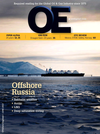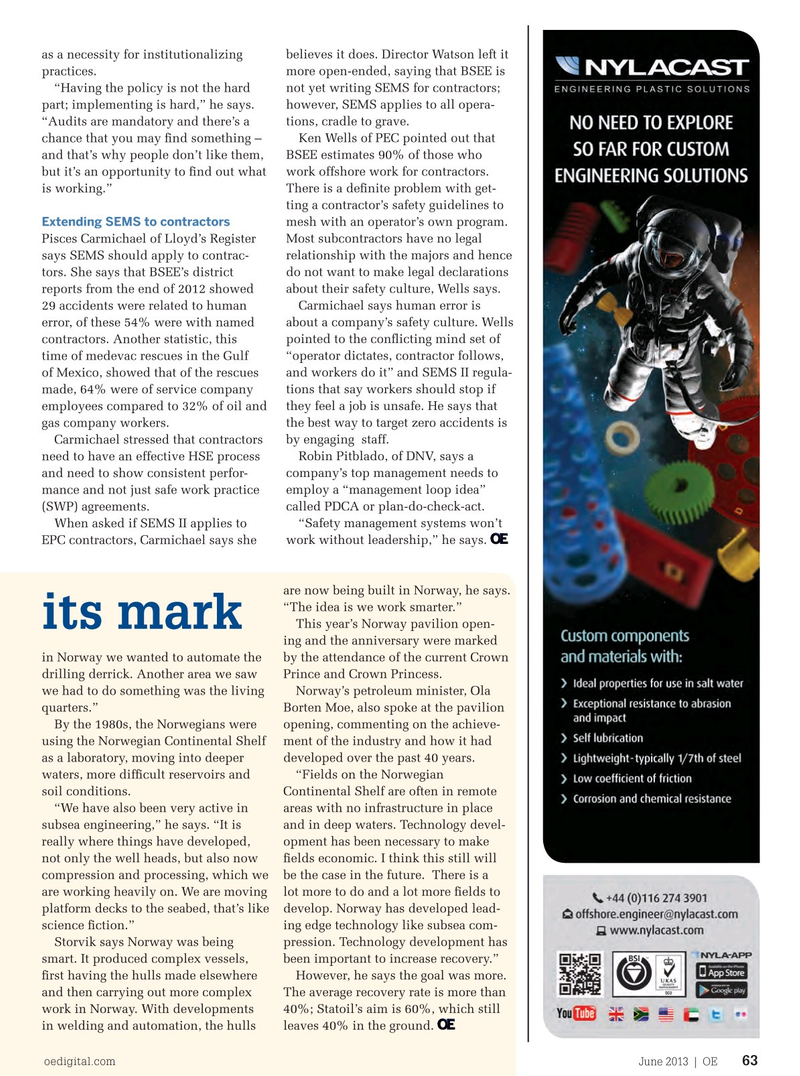
Page 61: of Offshore Engineer Magazine (Jun/Jul 2013)
Read this page in Pdf, Flash or Html5 edition of Jun/Jul 2013 Offshore Engineer Magazine
as a necessity for institutionalizing believes it does. Director Watson left it practices. more open-ended, saying that BSEE is “Having the policy is not the hard not yet writing SEMS for contractors; part; implementing is hard,” he says. however, SEMS applies to all opera- “Audits are mandatory and there’s a tions, cradle to grave.
chance that you may fnd something – Ken Wells of PEC pointed out that and that’s why people don’t like them, BSEE estimates 90% of those who but it’s an opportunity to fnd out what work offshore work for contractors. is working.” There is a defnite problem with get- ting a contractor’s safety guidelines to mesh with an operator’s own program.
Extending SEMS to contractors
Pisces Carmichael of Lloyd’s Register Most subcontractors have no legal says SEMS should apply to contrac- relationship with the majors and hence tors. She says that BSEE’s district do not want to make legal declarations reports from the end of 2012 showed about their safety culture, Wells says.
29 accidents were related to human Carmichael says human error is error, of these 54% were with named about a company’s safety culture. Wells contractors. Another statistic, this pointed to the conficting mind set of time of medevac rescues in the Gulf “operator dictates, contractor follows, of Mexico, showed that of the rescues and workers do it” and SEMS II regula- made, 64% were of service company tions that say workers should stop if employees compared to 32% of oil and they feel a job is unsafe. He says that gas company workers. the best way to target zero accidents is
Carmichael stressed that contractors by engaging staff.
need to have an effective HSE process Robin Pitblado, of DNV, says a and need to show consistent perfor- company’s top management needs to mance and not just safe work practice employ a “management loop idea” (SWP) agreements. called PDCA or plan-do-check-act.
When asked if SEMS II applies to “Safety management systems won’t
EPC contractors, Carmichael says she work without leadership,” he says. are now being built in Norway, he says. “The idea is we work smarter.”
This year’s Norway pavilion open- its mark ing and the anniversary were marked in Norway we wanted to automate the by the attendance of the current Crown drilling derrick. Another area we saw Prince and Crown Princess. we had to do something was the living Norway’s petroleum minister, Ola quarters.” Borten Moe, also spoke at the pavilion
By the 1980s, the Norwegians were opening, commenting on the achieve- using the Norwegian Continental Shelf ment of the industry and how it had as a laboratory, moving into deeper developed over the past 40 years.
waters, more diffcult reservoirs and “Fields on the Norwegian soil conditions. Continental Shelf are often in remote “We have also been very active in areas with no infrastructure in place subsea engineering,” he says. “It is and in deep waters. Technology devel- really where things have developed, opment has been necessary to make not only the well heads, but also now felds economic. I think this still will compression and processing, which we be the case in the future. There is a are working heavily on. We are moving lot more to do and a lot more felds to platform decks to the seabed, that’s like develop. Norway has developed lead- science fction.” ing edge technology like subsea com-
Storvik says Norway was being pression. Technology development has smart. It produced complex vessels, been important to increase recovery.” frst having the hulls made elsewhere However, he says the goal was more. and then carrying out more complex The average recovery rate is more than work in Norway. With developments 40%; Statoil’s aim is 60%, which still in welding and automation, the hulls leaves 40% in the ground. oedigital.com June 2013 | OE 63 otc.indd 63 5/27/13 9:30 AM

 60
60

 62
62